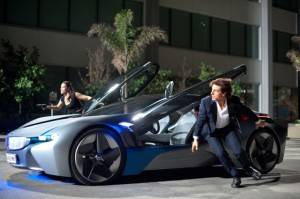Much like the “Alien” franchise, the most interesting aspect of the “M:I” films is the game of directorial musical chairs the franchise plays. The only constant is Tom Cruise as both the star, as heroic IMF agent Ethan Hunt, and also as the series producer. Each installment has a different director who brings a different sensibility and style to them. Brian DePalma kicked off the series with a film that contained his trademark themes of voyeurism and the slippery nature of truth, while also featuring his usual Hitchcockian set pieces. John Woo’s sequel is full of romance; both in the storyline and his graceful slo-mo infused stylization. JJ Abrams’ “M:I 3” is a surprisingly dark and energetic entry with Abrams’ usual plot complexities and sentimentality. The fourth entry is made by Brad Bird, his live action debut following his brilliant animated films “The Iron Giant,” “The Incredibiles,” and “Ratatouille.” Bird brings his style to the series, giving “Mission Impossible: Ghost Protocol” a fizzy energy that crackles with humor and humanity.
In contrast to Abrams’ third film, which featured plots within plots and double crosses galore, Bird’s film tells a relatively straightforward story. After a crazed Russian nuclear expert Kurt Hendricks (Michael Nyqvist) bombs the Kremlin and frames Hunt and his IMF team, the entire IMF is shut down. Working alone, Hunt’s team, including Agent June Carter (Paula Patton), tech expert (Simon Pegg), and mysterious “analyst” Brandt (Jeremy Renner), must work alone to stop Hendricks from launching a nuclear weapon and inciting World War III.

By having a more streamlined storyline, Bird is able to play up the interactions within the team. This is the first film in the series that truly puts the emphasis on the team and much of the humour and heart of the film comes from these characters coming together and bonding to achieve their common goal. The supporting cast are much more engaging than in other entries; Renner brings his trademark mix of amiability and intensity, Patton is a capable and believable female action heroine, and Pegg is an effective comic relief as always.
Bird’s filmmaking style also contributes to this more human tone. Unlike the other directors in the series he is less of a visual stylist and prefers a more classical “invisible” directorial style . This gives more focus on the performances and on the story allowing the characters and the actors more room to breathe than in previous entries. Bird’s experience as an animator gives the action sequences the feel of a live action cartoon. His construction of action is reminiscent of Spielberg, with an emphasis on visual gags, reversals, and comic suspense rather than brutal fistfights and disaster porn that is so prevalent in modern Hollywood. The highlight of the film is the celebrated scene of Hunt climbing up the side of the Burj Khalifa Hotel in Dubai, the world’s tallest building. The scene is tense, funny, and has a sense of scale and physical reality missing from CGI filled blockbusters.
The final problem is Cruise himself. There is no denying that he is endlessly watching as an action man, his physical grace and willingness to perform his own stunts make him a convincing hero. However, there is a blandness to the character of Ethan Hunt throughout much of the series. With the exception of the third film, where Abrams’ attempt to humanize Hunt was only partially successful, we never really get under the skin of Hunt’s character. In this film the idea is that Hunt is now the old head, mentoring the inexperienced team through their mission. However, for much of the film Hunt is a remote and aloof presence. It doesn’t help that whilst the rest of the cast buy into Bird’s lighter, comic tone, Cruise is stiff and humorless. Any time Bird attempts to have him inject any slyness or humor he seems overly mannered and uncomfortable. If only Cruise could get back to the energy of his youth. Look at his more natural, relaxed performances under Tony Scott’s direction in “Top Gun” and “Days of Thunder” to see how he has become a more self-conscious performer.
Overall, Brad Bird has reinvigorated the “M:I” franchise but injecting a welcome sense of humor and a zesty energy into his installment of one of the most consistently entertaining action franchises of the last twenty years.
– by Craig Adgie